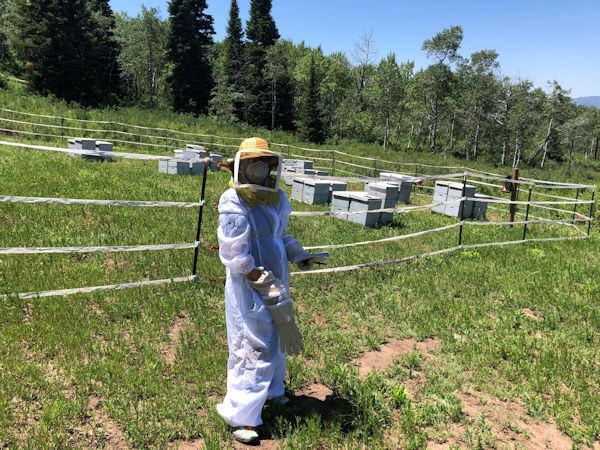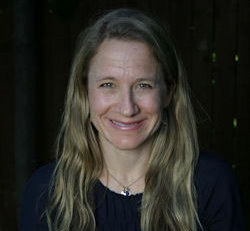SEJournal Online is the digital news magazine of the Society of Environmental Journalists. Learn more about SEJournal Online, including submission, subscription and advertising information.
 |
| The author at the Cox apiaries in Utah's Uinta-Wasatch-Cache National Forest. Photo: Courtesy Jennifer Oldham. Click to enlarge. |
FEJ StoryLog: Grantee Suits Up To Ask If Honeybees Harm Native Species
By Jennifer Oldham
Orange-banded bees weighed down by pollen and nectar crash into grass and shrubs, then tumble to the ground. They right themselves, take off unsteadily and fly into a hive to disgorge their load to make honey.
It’s a struggle I watched play out among millions of domesticated honeybees in Utah’s Uinta-Wasatch-Cache National Forest for a reporting project supported by the Society of Environmental Journalists’ Fund for Environmental Journalism, or FEJ.
The FEJ grant offered an opportunity to write about the impacts of commercial beekeepers moving their hives to public lands as traditional acreage for their hives, like croplands, shrinks.
Those onsite visits, clad in beekeeping gear (a heavy white nylon suit, elbow-length leather gloves and a helmet with a veil), allowed me to commune with the buzzing creatures — absent the fear of being stung. It was a singularly joyful and educational experience.
Grant offered time, money
 |
| Jennifer Oldham. |
Key questions had long intrigued me: Were apiaries on public lands endangering native bees? How many honeybees spend their summers in national forests, and on public grasslands and deserts? What does science say about how this nonnative species affects sensitive ecosystems?
The grant provided the time and money needed to answer those questions. With it, for example, I was able to spend days analyzing thousands of documents, obtained by conservationists under a Freedom of Information Act request, to determine the scale of the issue.
Piecing together who held permits to keep apiaries on forests and deserts in Utah, Arizona and Colorado required lots of reading, note-taking and phone interviews with scientists and public land managers.
To learn more about why permit holders wanted to use public lands, I contacted Dennis Cox. The fourth-generation beekeeper parks 592 of his 5,700 hives on national forest lands northeast of Salt Lake City each summer.
The grant money allowed me to visit Cox in Logan Canyon, where his bees — he calls them “livestock” — spend four months rebuilding their population lost to disease and pesticides after months pollinating California’s almond groves.
COVID-19 required precautions
The coronavirus added a day onto the trip because I didn’t want to fly to Utah in July 2020. Instead, I drove eight-and-a-half hours each way — with additional hours in the car while I was there because I didn’t believe it was safe to ride with others.
Things became more complicated when I arrived. Cox shared he had been exposed to COVID-19 a few days earlier. We decided to wear N-95 masks and to socially distance, even outside.
The project didn’t require any reporting work indoors, so Cox and I visited various colonies and discussed how his company was being impacted by a loss of cropland — where apiarists previously parked their bees — to development and row crops.
Cox’s honeybee colonies are among thousands of hives belonging to 112 apiaries permitted in national forests by the U.S. Department of Agriculture, with no environmental review and despite uncertainty among scientists about how the non-native insects impact wild bee populations and rare plants that rely on them for pollination.
It took months (and reading dozens of peer-reviewed studies) to unravel the often contradictory science around this question.
Field observations provided ‘wealth of color’
The FEJ grant also allowed me to spend time during my trip to Utah with federal scientists at a USDA bee lab in Logan and a study site in Strawberry Valley.
Researchers at Strawberry Valley are studying how the pollinators interact and plan to identify pollen removed from bumblebee and honeybee hives in the valley to pinpoint the flowers each species visits.
My observations at the Strawberry Valley site …
provided a wealth of color for the piece that
wouldn’t have been available over the phone.
My observations at the Strawberry Valley site, where the sounds of quaking aspen mingled with the drone of well-fed bees, provided a wealth of color for the piece that wouldn’t have been available over the phone.
Back at the USDA bee lab in Logan, its research director explained the study’s methodology to me while we sat at a shaded picnic table on a two-acre plot behind the facility. Here, entomologists raise and nurture bee colonies and plants to learn about pollinator behavior.
Studying pollinators and how they interact in the wild is time-consuming, expensive and tedious. Fieldwork allowed me to show this up close. It also helped me to determine that more analysis is urgently needed to understand if honeybees’ voracious appetites strip the land of food for native bees; if pollinators transmit diseases and parasites to one another; and if honeybees’ preference for invasive species will alter ecosystems.
Tips for grant applicants
Reporting this piece taught me many things. Among the lessons: It takes humility and patience to effectively use multiple databases to manipulate huge amounts of information. It also reinforced for me that being flexible in the field, and coming prepared to spend extra time, is one of the top skills journalists can bring to their work.
Journalists interested in applying for grants should read stories awarded grants in the past and note their themes, reporting styles and other attributes. Ask the journalists about how they framed their applications. Also, study grant applications carefully, make sure to answer questions posed in the guidelines and provide all information requested.
In the end, the grant assisted me in publishing in YaleE360 the story, “Will Putting Honey Bees on Public Lands Threaten Native Bees?” The investigation garnered hundreds of shares, Facebook interactions and tweets.
In addition, thousands of readers were measured spending nearly five minutes on the page, which editors who praised the piece said showed that most people who started reading finished it. And certainly part of what drew readers through the story were the details obtained with the vital help of the FEJ grant.
Jennifer Oldham is a Pulitzer Prize-winning journalist who specializes in covering economic inequality, energy, the environment, politics, policy and public lands. Her work has appeared in National Geographic, Politico Magazine, The Washington Post and Reveal at The Center for Investigative Reporting, among others. She was previously a national correspondent at Bloomberg News and a staff writer at the Los Angeles Times.
* From the weekly news magazine SEJournal Online, Vol. 7, No. 2. Content from each new issue of SEJournal Online is available to the public via the SEJournal Online main page. Subscribe to the e-newsletter here. And see past issues of the SEJournal archived here.













 Advertisement
Advertisement 



